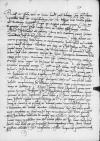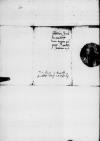List #256
Vicar of St. Nicholas Church in Bari & Chapter of St. Nicholas Church in Bari do Ioannes DANTISCUSBari, 1525-08-03
| odebrano Toledo, [1525]-09-25 Rękopiśmienne podstawy źródłowe:
Publikacje:
| ||||||
Tekst + aparat krytyczny + komentarz Zwykły tekst Tekst + komentarz Tekst + aparat krytyczny
Magnifico ac paper damaged⌈[Magnifico ac]Magnifico ac paper damaged⌉ celeberrimo iuris utriusque doctori, domino
Etsi alteras externis diebus ad Magnificentiam Dominationis Vestrae dedimus litteras humiliter petentes, uti oratorem serenissimarum
Volentes tamen,
cf. Cic. Fam. 2.6 ⌊cui multum debemus, illi plurimum velle deberi iuxta illud Ciceroniscf. Cic. Fam. 2.6 ⌋, confisi de summa virtute et devotione Vestra, quam geritis erg{r}a mirificum hunc Christi confessorem divum Nicolaum, patronum nostrum, rogare non desinimus et exorare Dominationem Vestram, quatenus dignetur intercedere pro nobis coram
Quod indubitanter ad votum subcedet, si Dominatio Vestra suum nobis praestiterit auxilium et favorem, in uno tamen dignetur advertere, quod magnificus dominus  BCz, 243, p. 26 dubitamus, ne ex affectione pristini patrocinii conetur impedire expeditione huius nostrae supplicationis, in quo poterit supplere prudentia Vestra et quamvis Dominatio Vestra de tantis laboribus habebit gloriosum divum Nicolaum pro se in celestibus intercessorem et munerum largissimum retributorem, nos omnes in genere et in specie habebit perpetuo obnoxios et pro salute animae et corporis ac felici regressu ad patriam suam continuo orantes.
BCz, 243, p. 26 dubitamus, ne ex affectione pristini patrocinii conetur impedire expeditione huius nostrae supplicationis, in quo poterit supplere prudentia Vestra et quamvis Dominatio Vestra de tantis laboribus habebit gloriosum divum Nicolaum pro se in celestibus intercessorem et munerum largissimum retributorem, nos omnes in genere et in specie habebit perpetuo obnoxios et pro salute animae et corporis ac felici regressu ad patriam suam continuo orantes.
Vale.
Dat(ae) or Dat(um)⌈Dat(ae)Dat(ae) or Dat(um)⌉
Eidem Vestrae Dominationi obsequentissimi vicarius et capitulum regalis ecclesiae s(ancti) N(icolai) de(?) Baro hidden by binding⌈[o]o hidden by binding⌉


